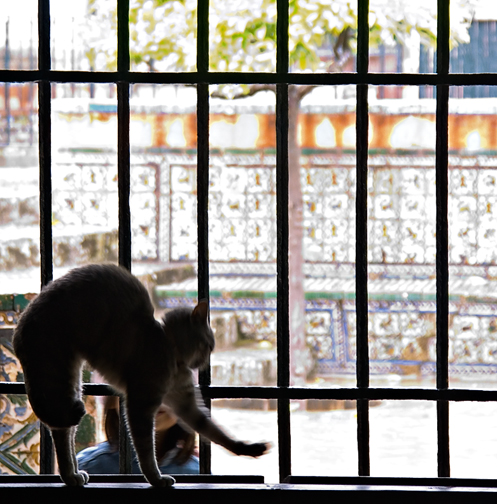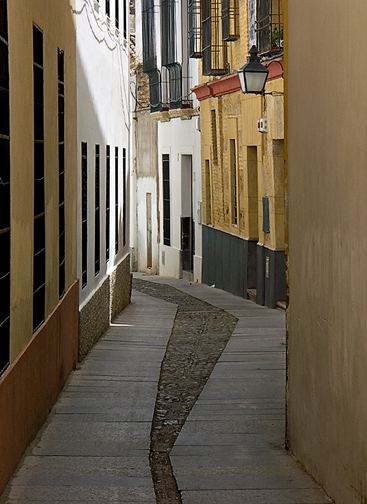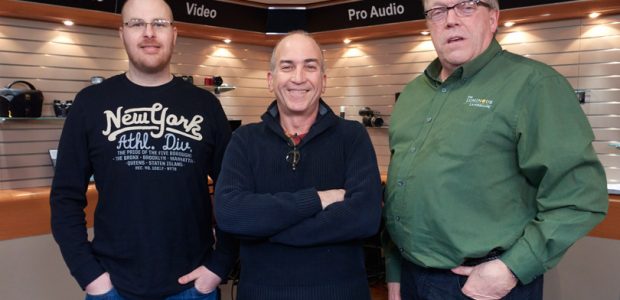In late 2003 when I tested theSony F828, the first of the current generation of 8 Megapixel digicams, I was generally impressed and found it to be a camera that could be used for more than just casual applications. I therefore took it to Africa on a Safari workshop which I conducted in Tanzania in January of 2004, and was able to produce some very fine images with it.A write-upon that experience is online.
This lead to my conductingreviewsof all five 8 MP cameras, and I ended up purchasing theMinolta A2for my own use. Not long afterward I went on a ten day vacation to Spain, which would include traveling through Andelucia and Catalonia as well as attending theSpring Fairin Seville anda bullfight. What camera to bring?
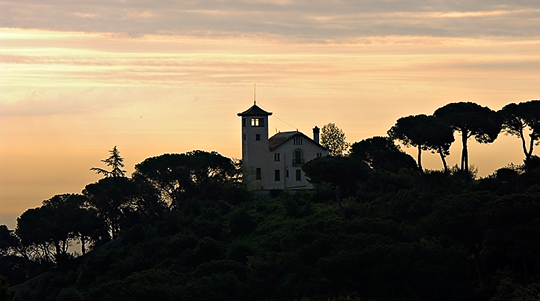
Dawn Above Barcelona — April, 2004
Minolta A2 @ ISO 64
I decided that the Minolta A2 would likely be ideal. There was no way I was going to need my Contax medium format equipment with 16 MP digital back, and the Canon 1Ds and a selection of lenses would simply be too cumbersome for an urban vacation. Even the Canon 10D and a couple of lenses would be more than I wanted to carry on holiday. But like the little Sony, the Minolta would easily fit in a coat pocket or shoulder bag, and could be carried for the long hours that I knew I would spend walking the streets of Barcelona, Seville and Cordoba. Street photography is what I do when I travel for pleasure, and the small size and weight of the camera that I’m using is the key to not tiring on a day with 10-12 hours of walking the streets of a strange city.
Walking Around
This report will serve two purposes. I’ll use it to describe my impressions of the good and bad of the Minolta A2, and also as a venue for some photographs taken on this trip. Don’t associate a particular image with any comments, pro or con, unless I specifically make that link. Otherwise the images are simply here for viewing.

Coke Sign and Wall — Seville, Spain. April, 2004
Minolta A2 @ ISO 64
During the many years that I shot with film an M Series Leica was my constant companion when I traveled abroad. Whether on a business trip, an assignment or a vacation, the Leica’s light weight and small size often made the difference between getting the shot, and not. You can own the world’s best camera and sharpest lens, but if it’s in a cupboard back home or in the hotel room, you won’t get the shot.
Camera’s like the Minolta A2 have for me taken the place of a Leica M6. No, I’m not saying that they are built as well, have as good lenses or are as fast to use. But, when it comes to size, weight and convenience a camera like this can do a very similar job in many situations. When a digital M6 equivalent comes out I’ll be among the first to make the jump, but for now the A2 is proving to perform the task very well.
Anti-Shake
Some years ago when I reviewed the first Canon lenses with Image Stabilization I described them as offering possibly the greatest advance in photography of the past half century. I still feel that way, and have been able to produce some successful images with my 35mm Canon system that otherwise wouldn’t have been possible. The A2 (like its predecessor the A1) has what Minolta calls Anti-Shake, which accomplishes the same thing as Canon’s Image Stabilization or Nikon’s Vibration Reduction. But instead of moving lens elements to compensation for camera shake it moves the sensor.
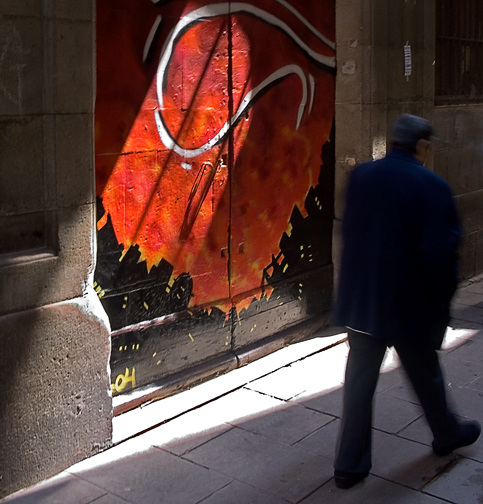
Walking Past the Red Door — Barcelona, Spain. April, 2004
Minolta A2 @ ISO 64
1/20 second @ f/5.6. 35mm Equiv.
Regardless of how it does it, it does a great job. The shot above was taken hand-held at 1/20 second, a shutter speed guaranteed to induce hand shake. While the man is blurred by his motion, the background red door, which is what I was focused on, is tack sharp.
Focus Issues
There has been much discussion on web forums about focus problems with the A2. Some people have returned their cameras, claiming that they don’t focus reliably. It needs to be said that the A2’s focus system is complex, and the manual does not explain it all that well.Johan Brandershas produced a very fine explanation of the A1 and A2’s focus modes which can befound here.
It’s been my experience that the A2’s Wide Area focus mode can often lock on to the wrong subject. More so than other camera systems that I have used. For this reason I use theFlex Pointfocus mode instead, and find that it does a superb job.
What I have also found is that sometimes the camera simply looses its mind. By this I mean that no matter what one does the camera will simply not focus reliably. The solution is to re-boot. Turn the camera off and then on again. This is likely the explanation for why some people claim that they get many poor images. The camera has obviously gotten itself into this state, and likely the photographer is simply trusting that the camera’s autofocus is doing its thing properly. It isn’t. The solution (until Minolta admits the problem and introduces a fix) is to pay attention to what the camera is doing and use theFlex Pointmode whenever possible. When in doubt — reboot.
Update:In early June, 2004, Minolta posted on its web sites around the world a firmware update that addresses these problems. Here is a link to theKonica / Minolta U.S. web site. The problems that have been addressed with this firmware release (V1.12u) are (to quote Minolta)…
— Improved the symptom that visibility of LCD decreases depending on the subject brightness while using the Flex Digital Magnifier function.
— Improved the symptom that LCD turns off or the camera cannot focus on the high brightness subject with the Flex Focus Point at the focal length of 100mm.
— Improved the flash metering accuracy.
— Changed the viewfinder operation from the viewfinder turns off immediately after leaving the eye to it remains 10 sec. when the display mode switch is at EVF
Stretching at the Alcazar —Seville, Spain. April, 2004Minolta A2 @ ISO 64
1/8 second @ f/3.5. 200mm Equiv.Softness
Another area which I have seen commentary on is that the A2’s images are not as sharp as they should be, and that this means that the camera’s lens may not be as good as that of competitive cameras. This is not the case. The lens is very good indeed. The issue is thatRAW mode imagesare softer than those from some other cameras and needs a greater level of sharpening that users may be used to with their previous cameras.
As long-time readers and advanced digital photographers likely know, sharpening of digital files has nothing to do with sharpness. It has to do with edge contrast, otherwise known as accutance. Sharpening was a poorly chosen word when it was applied to theUnsharp Maskingprocess (another poorly chosen word used to apply to a digital process that has its origins in the film world). In any event, this simply means that Minolta is trying to provide you with as virgin a file as possible, and it’s then up to you to make the most of this. I much prefer this approach to the one taken by Canon, which has admitted that it even sharpens RAW files in-camera.Mother, please! — I’d rather do it myself.
Since I rarely shoot JPGs I can’t comment on how much additional sharpening may be needed following different in-camera sharpening settings. But, if sharpening is applied properly in post processing results are superb — as good as or better than those from any other 8 MP digicam.
My preferred method of sharpening is to use thePhotokit Sharpenerplug-in for Photoshop. Its three-stage process allows for fine tuning the sharpening process to a degree not possible with any other program that I’m aware of, and is ideal for a camera like the Minolta A2, which has special sharpening needs.
Handling
Some cameras take a while for me to warm up to, others never do so, and a few are found to be comfortable to use from the start. I found the A2 to be a very easy camera to get to know, and even though it has a great many features it wasn’t more than a few days before using the camera became almost second nature. This for me is the hallmark of a good design — when you can stop thinking about what control does what, and begin to ignore the camera in favour of simply doing photography.
Noise
There’s no getting away from it. The current crop of 8 Megapixel cameras are noisier than the current crop of 6 Megapixel DSLRs. At ISO 64 and 100 the Minolta A2 is very clean. A3 sized prints show just a slight amount of noise. Certainly less than most film I’ve used. At ISO 200 the grain becomes noticeable, but a good noise reduction program likeNoise Ninjacan make an ISO 200 image look like ISO 100, and an ISO 400 image look like ISO 200.
But, there’s no escaping the fact that current DSLRs are essentially noise free up to ISO 400, and some are really good even at ISO 1200, especially with noise reduction applied in post-processing. With the A2 and the other current 8MP camera ISO 400 verges on the unacceptable.
Viewfinder Issues
There’s good news and bad news when it comes to the A2’s viewfinder. The A2’s EVF is the best one currently on the market. It has very high resolution — nearly 1 million pixels. But, like all EVF’s it simply can’t handle the dynamic range of the real world. It is much more limited than what a digital sensor can capture.
Cordoba Laneway — Spain, April, 2004
Minolta A2 @ ISO 64
The frame above is a good example. The dynamic range was huge, though with careful reference to the live histogram the camera was able to handle it very well. But the viewfinder simply showed the shadow areas as almost black. If it wasn’t for the live histogram I would have had no idea how the shot would turn out. This is why I regard a live histogram as a must with digicams and why it’s omission on the Canon Pro1 (alone out of the current crop of 8MP cameras) is such an oversight.
The bottom line with EVFs is to just use them for framing and to view the histogram, and to essentially ignore them for other aspects of judging the image.
What I did greatly appreciate is the automatic viewfinder switching that the Minolta offers — something that they appear to have a patent on because no one else is doing it. It is a real boon to working efficiently. I would be hard pressed in future to consider any digicam that didn’t offer this capability.
Flaws
There are a few design flaws. The one that became most annoying is that the top control dial for selecting shooting mode doesn’t lock. It is all too easy for it to accidentally become dislodged and set to a shooting mode other than the one that you want. A center button that needs to be pressed while the knob is turned would solve this.
The tilting EVF should also have a locked position. It is always swinging upward when it brushes against my body while on a shoulder strap. While the hinge seems rugged, it’s likely just a matter of time till something breaks.
RAW Mode
Regular readers will know that I only shoot in RAW mode. There seems little point to me in shooting JPGs for anything other than the most casual snapshots. The Minolta is one of only two digicams that can shoot more than one RAW frame without chocking. The other is the Canon Pro1. The A2 can do up to three RAW frames at 2.7 FPS while the Canon can do up to 5 frames but at a much slower 1 FPS.
For most shooting the Minolta’s three frames were adequate, but when shooting at thebullfight in Sevilleit simply wasn’t fast enough, and I lost a lot of good potential frames. A DSLR would have been a much better choice from that point of view for fast action shooting.
Stern Looks — Seville, Spain. April, 2004Minolta A2 @ ISO 200
The Bottom Line
After some 2,000 frames over a 10 day period I ended up being quite pleased with the Konica-Minolta A2. It’s low weight and bulk, along with small size, married with an 8 Megapixel sensor and a wide-range reasonably fast zoom is a dream come true. What once would have taken a heavy shoulder bag full of cameras and lenses can now fit in a large coat pocket, or be carried in one hand for hours at a time.
Image quality, while not up to that from a good DSLR, is quite good, and I easily was able to produce some exhibition and publication quality images with it.
Clearly digicams are in transition. High pixel count sensors are no longer the exclusive domain of DSLRs. Naturally the smaller sensor size and thus smaller pixel size of digicams means that except at the lowest ISOs noise can be an issue, but the tradeoff can be worthwhile. While DSLRs will always maintain their edge in this area, speeds up to ISO 200 are very good, especially when good noise reduction software is used. Again, it’s a matter of trade-offs. Small size and low weight in exchange for occasional greater noise.
I fully expect that digicams are going to rapidly make a transition from being considered amature-only gear to respected alternate tools for pros and more serious photographers. With cameras like the A2 we’re almost there. In another year or two there won’t be any question.
You May Also Enjoy...
Get Off Your Fat Blog and Take A Picture
A few weeks ago Chris Sanderson and I were in New York City working on a number of different video projects. While there I was
